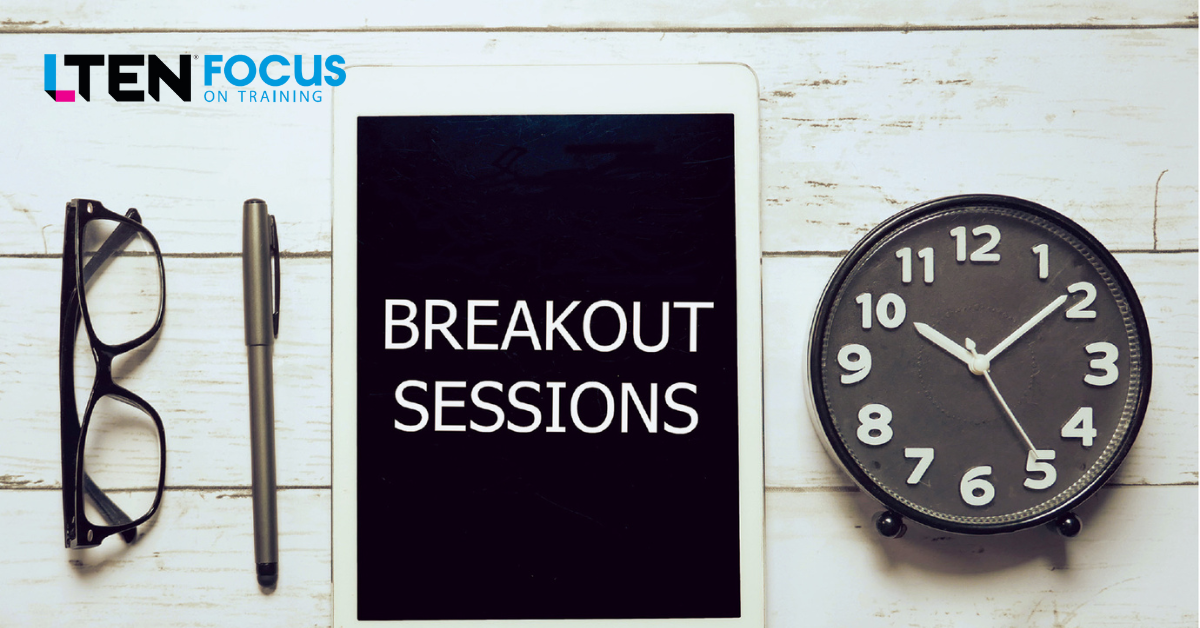
Virtual Training — Cindy Huggett, CPTD
Successfully facilitated breakouts have three key components
 The most effective virtual classes focus on social connection and conversation. Instead of relying on a presenter’s monologue, they are filled with robust dialogue. Participants actively engage with the content, the tools and one another.
The most effective virtual classes focus on social connection and conversation. Instead of relying on a presenter’s monologue, they are filled with robust dialogue. Participants actively engage with the content, the tools and one another.
One of the best ways to create this type of environment is through small group collaboration, namely, breakouts. Breakouts easily allow for small group activities in virtual classes. Participants go into private rooms, which are smaller sub-conferencing spaces, where they can hear and see one another. In breakouts, groups can brainstorm ideas, discuss challenges or practice new skills together.
Successfully facilitated breakouts have three key components: They are mindfully created, managed well and meaningfully debriefed. Let’s look at the details behind each one.
Mindfully Created
Effective breakout rooms should be intentionally created to accomplish the learning task at hand. Facilitators determine the activity scope, timing and ideal breakout configurations. These aren’t last-minute decisions but instead ones carefully considered in advance.
For example, determining the breakout group configuration requires forethought. Will you assign participants to a group or allow them to choose their own? Will you randomly place people together or attempt to align them by location, role or other means? The answer depends upon the activity purpose, but it shouldn’t be left to chance.
In addition, a typical small group size in traditional classes is five to seven participants. However, in virtual classes, I almost always recommend groups of three people each. A trio is large enough so that if one person has a tech challenge, there are still two others available to complete the activity. Yet it’s small enough to allow for everyone’s input. It’s hard to “hide” in a trio.
Of course, there are some activities that benefit from a larger group size, and others that are perfect for pairs, but when possible, go for groups of three.
Also, facilitators should plan to share activity directions both verbally and visually. This means creating a slide, handout or other visual aid that includes explicit instructions for the exercise. With participants divided into separate virtual spaces, they need to know exactly what to do and why they are doing it. These instructions should be shared and available for easy reference throughout the activity.
Managed Well
Breakout rooms should feel smooth and seamless to participants, without bumpy transitions or awkward pauses. The collaborative activity is introduced and explained, and participants can focus on the task instead of the technology.
There are several nuanced facilitation techniques that create this flawless experience.
First, facilitators should discover their platform’s breakout room settings so that the full capabilities are available. Automatic timers help participants keep track of time expectations. Broadcast messages allow the facilitator to send prompts to each group to guide them along, or to check in as needed. Countdown alerts give groups sufficient warning to save their files and wrap up their conversations. Each of these technical tools adds subtle but important benefits for the group.
Another way to help participants maximize their time in breakout activities is to get them working together as quickly as possible. This can be accomplished by assigning roles before the groups begin.
For instance, a facilitator could announce who is assigned to each group, and name someone in each group as the discussion leader. Or, a facilitator could say, “When you get into your groups, the person whose name is at the top of the participant list should begin the conversation, and the person at the bottom should take notes.” This simple yet powerful instruction ensures the conversation flows quickly because someone takes ownership. Otherwise, groups may lose valuable time just figuring out who should speak first.
Meaningfully Debriefed
Once participants return from breakout activities, it’s important to balance the need for reflection and debrief discussion without repeating the entire breakout conversation. Interactive debrief methods keep everyone engaged in the conversation instead of giving the microphone to one person at a time.
If each group needs to report out, then invite them to share one highlight from their breakout, avoiding anything that has already been said by another group.
Or, facilitators can post a poll question with common items that were likely to have surfaced. Invite participants to select which topics their group discussed during the activity, so that you can reveal the post-poll results and patterns. Be sure to include “other” as a poll response to capture the remaining unique topics.
If groups need to share a whiteboard, ask their spokesperson to specifically “tell us one place on your board we should look” so that the debrief can stay focused on the essentials.
Conclusion
Breakouts are associated with increased engagement and therefore better learning results. Use them liberally in your virtual classes to encourage collaboration and conversation, while incorporating the above techniques to ensure they contribute to a positive learning experience.
 Cindy Huggett, CPTD, is a consultant and author whose books include The Facilitator’s Guide to Immersive, Blended and Hybrid Learning and Virtual Training Tools and Templates. Email her at Cindy@CindyHuggett.com.
Cindy Huggett, CPTD, is a consultant and author whose books include The Facilitator’s Guide to Immersive, Blended and Hybrid Learning and Virtual Training Tools and Templates. Email her at Cindy@CindyHuggett.com.








